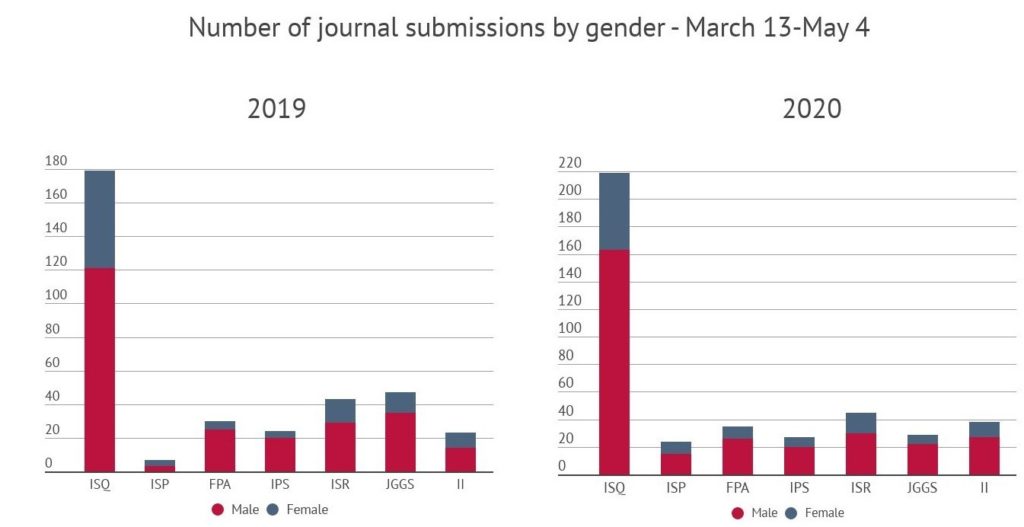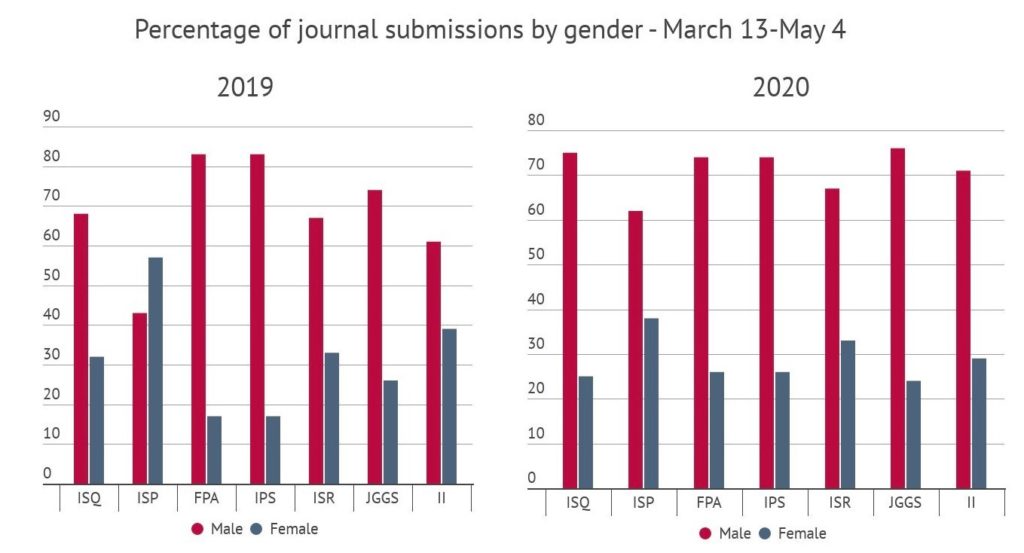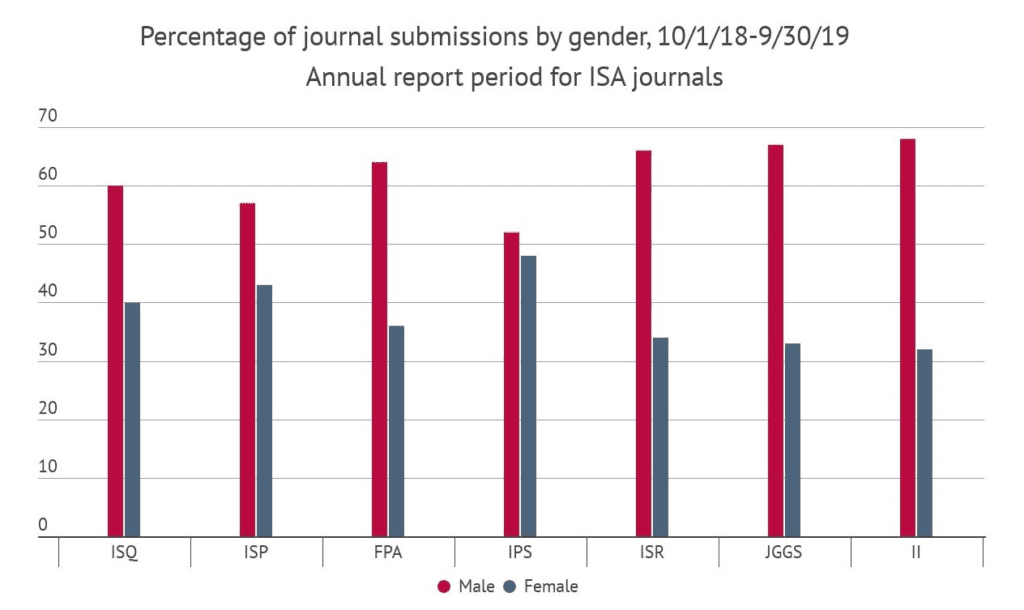The following is a post by ISA journal editors Krista Wiegand (International Studies Quarterly), Debbie Lisle (International Political Sociology), Amanda Murdie (International Studies Review), and James Scott (International Studies Perspectives).
There has been a lot of talk in academia about the many negative consequences the COVID-19 pandemic has generated, ranging from declining enrollments, inability to travel for field research or conferences, and research productivity working from home. As editors of the International Studies Association (ISA) journals, we started noticing some new trends in submissions as the COVID-19 pandemic accelerated. First, submission rates were up for almost all the ISA journals. When we checked the submission rates from March 13 – the average date that most universities shifted to online classes – to May 4 this year, compared to the same time period last year, most of the journals had a higher number of submissions, ranging from a 17% to 343% increase compared to the same time period last year. However, we also noticed that submission rates by female scholars were down — at least proportionally — in most of the journals. When we compared the submission rates by women to “normal” times, we saw a clear decline. For example, in International Studies Perspectives, the proportion of submitted manuscripts including at least one female co-author declined by over 19% compared to the same time period last year.
This trend in increased submissions does not appear to be unique to ISA journals; we know from social media that several IR and political science journals have seen an uptick in submission numbers since mid-March. The editors of Comparative Political Studies and American Journal of Political Science noticed the trends as well. Outside of political science and international studies, other academic fields have started highlighting the same trends, getting attention in mainstream media like The Guardian. In economics, one study found that the productivity of women and mid-career faculty, as measured by submission of recent working-papers, was disproportionately down during lockdown. There have been similar discussions about women’s reduced productivity in journal submissions in the sciences.


COVID-19 disruptions are likely to affect researchers differently across a host of dimensions, including gender, differences in family dynamics, and access to resources. Nevertheless, there could be several explanations for the substantial increase in submissions. For one, because the annual ISA annual convention was cancelled, scholars who had papers ready to present could have submitted their papers to ISA journals instead of taking them to the conference, gathering feedback, and then taking time to revise their papers. Yet, some scholars may have found that the shift to online teaching from home actually gave them additional time and allowed them to be much more productive than typical.
On social media, there have been speculations about the disparity of gender roles in childcare and home-schooling resulting from the shutdown of daycares and schools. On Twitter, many argued that women tend to provide the majority or all childcare and/or home-schooling, and therefore women scholars have had less time to devote to research and writing when compared to male scholars. We also know that women historically have had a larger role in elder-care and dependent-care; shelter-in-place orders could exacerbate these related tasks.
Examining the COVID-19 influenced numbers we gathered was a strong reminder that female author submissions – especially solo authored or two or more women-only authors – are significantly low in all ISA journals. This is not a surprising finding. As editors, we compile data for our annual reports every year and the numbers are not looking better from year to year. Across our journals, the discrepancy ranged from about a ten percent gap to almost 40%. For example, for the flagship journal of ISA, International Studies Quarterly (ISQ), the 2018-2019 annual report shows that 60% of submitted manuscripts were authored by males, either solo or all male teams. This compares to only 21% manuscripts submitted by solo or all female teams of authors. For other ISA journals, the numbers are similar; Foreign Policy Analysis, International Interactions, International Studies Review, and Journal of Global Security Studies all had about two times the number of submissions from males than females; while International Studies Perspectives and International Political Sociology had smaller differences, both were still sizable.

Our evidence here reflects a broader issue, with lasting repercussions contributing to a “leaky pipeline” and diminished numbers of women at senior levels in our field. Efforts to cite and encourage female scholars are being done by many scholars informally through Women Also Know Stuff, the Women’s Caucus section of ISA, and the Committees on the Status of Women in the Profession at ISA and APSA. There are several eye-opening studies on gender citations and the gender citation gap, an October 2018 special report published in PS about gender and publishing in several political science journals. Groups like the Danish Society for Women in Science are collecting data on female journal submissions, which will help track long-term trends.
How can women publish higher numbers of articles when they are submitting so much less than men? How can female citation counts go up if the pipeline is drier at the start and the supply is low? We know this is an issue that affects scholarship beyond the ISA journals. The COVID-19 pandemic has prompted us to start a conversation about changing these gender imbalances and discussing how we as journal editors can help to promote women to submit at higher rates than they currently are. We are talking with other journal editors and welcome suggestions from scholars about how to better address the gender gap in submissions.
Our thinking is a work in progress and involves a number of possibilities. Most importantly we encourage scholars to:
1. Become well-versed in the scholarship on gender and academia specifically and on diversity, bias, and the academy more generally. The first step for all of us is to understand the reality of the situation. For example, by informing graduate students of the gender citation gap early in their training, perhaps junior scholars will be better able to cite broadly or feel more empowered to submit their work.
2. Reach out to journal editors if you’re unsure about scope, topic, or overall fit.
3. Junior scholars – don’t hesitate to reach out to senior scholars to provide mentoring and networking. Senior scholars, please be willing to mentor junior scholars!
4. Present your work as much as possible, don’t be afraid to ask colleagues and more senior scholars to read your work, and submit to journals regularly. If you can’t attend conferences, present in your department, in an online colloquium, or even to a group of friends in your field.
5. Don’t hesitate to submit to higher ranked journals thinking that your work isn’t good enough for these journals. Don’t let the imposter syndrome prevent you from submitting.
6. Join a scholarly writing group in your subfield to provide support to each other and keep each other accountable (not holding off submitting your manuscript!).
7. Realize you are not alone and that disruptions (both COVID-related and not COVID-related) are affecting the productivity of many of your colleagues in different ways. Although we want you to submit your manuscripts, we do not want to put pressure on anyone to overwork themselves.
While many universities have provided an additional year on the tenure clock as a result of COVID-19 disruptions, not all universities have adjusted their policies yet. We hope our data show how the pandemic is affecting research submissions in the short-term in ways that may exacerbate the gender gap and leaky pipeline. Moreover, the crisis is affecting individuals across multiple dimensions in ways that may not be fixed by a one-size-fits-all additional year on the tenure clock.
As editors, we will work to try to improve the gender balance in submissions. As gatekeepers of scholarship in IR and international studies related topics, it is our job to make sure that everyone has equal opportunities to have his or her research reviewed professionally in a way that is helpful to submitting authors. We believe as editors that we may be able to take some steps to lower the barriers to submission on our end. Editors, editorial board members, and published authors can all help to encourage scholars to submit to certain journals. As editors, we should be able to provide advice, answer questions about the review process, and encourage scholars to submit to our journals when we see good work presented. This is a long-term issue that cannot be solved tomorrow, but starting with awareness and active encouragement will hopefully help to alleviate the gender imbalance in submissions.
Amanda Murdie is Professor & Dean Rusk Scholar of International Relations in the Department of International Affairs in the School of Public and International Affairs at the University of Georgia. She is the author of Help or Harm: The Human Security Effects of International NGOs (Stanford, 2014). Her main research interests include non-state actors, and human rights and human security.
When not blogging, Amanda enjoys hanging out with her two pre-teen daughters (as long as she can keep them away from their cell phones) and her fabulous significant other.


0 Comments
Trackbacks/Pingbacks